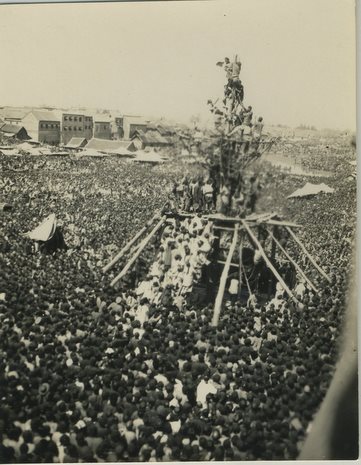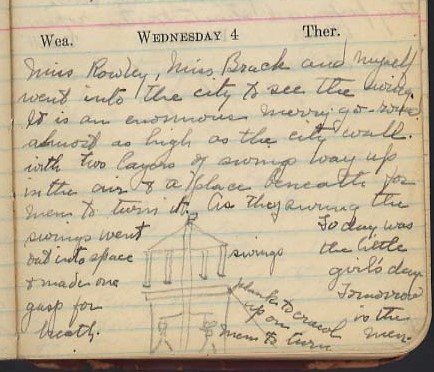Newly processed in Honnold Special Collections is the official record, in manuscript form, of the House of Commons during the first and second Parliaments of Charles II. The manuscripts are bound in three volumes covering the years 1661-1678. Call number J 301 .K2 1661.
On view below is the first page of the first volume, May 8, 1661:

Typically, Parliament secretaries took verbatim notes employing a variety of abbreviations and shorthand. These three volumes are elaborately written out longhand in red and black, with ornate initial letters at the beginning of each new section and flourishes and decorative pen work, clues that these volumes were commemorative, probably for a member of the House of Commons.
Stereotypes in Advertising exhibition–part 2
Stereotypes in Advertising: World War I and World War II Posters and Ephemera
The students of GRMT134: Stereotypes in Advertising, taught at Pomona College by Prof. Felix Kronenberg, are organizing a series of three exhibitions in Honnold/Mudd Library. On exhibit through the end of spring semester will be Special Collections’ World War I and World War II posters and ephemera as well as imagery and advertising of current world events.
The second of these exhibitions is “Wartime Patriotism: Past & Present”. A version of this in-library exhibition is also available as a web exhibition.
The students in this interdisciplinary course are exploring the depiction of the other in the world of advertising, looking at various stereotypes pertaining to categories such as nationality, ethnicity, gender, or age from a cultural studies perspective.
John Walker’s Arma Virumque Cano
New in Honnold Library Special Collections is John Walker’s Arma Virumque Cano (Untide Press, 1950).

Walker’s poem has twelve numbered parts; this is III:

The Untide Press carefully selected materials and design, and set all their work by hand. The press garnered awards for excellence in printing and design with William Everson’s War Elegies (1944), Jacob Sloan’s Generation of a Journey (1945) and John Walker’s Arma Virumque Cano (1950).
Letterpress printed in an edition of 500, Arma Virumque Cano was designed with linoleum cut decorations by Kemper Nomland, printed in Bembo and Futura types, hand-set, on Kilmory Text paper.
The Untide Press was founded by William Everson, Kemper Nomland, Kermit Sheets and William R. Eshelman, in a camp of conscientious objectors in Waldport, Oregon in 1943, as an expression of protest against World War II. The name of the press originated in opposition to the camp weekly called The Tide, the slogan of the press being “What is not Tide is Untide”. The Untide Press moved after the War to Pasadena, where they produced an occasional literary magazine and small books of poems, many of them by the poets and writers who were later to form the nucleus of the San Francisco literary renaissance.
The Rare Book Room at Denison Library and Special Collections, Honnold Library, have other examples of the work of William Everson and other mid-century poets and printers of the west coast of the U.S. The Papers of the Untide Press are at the Bancroft Library, UC Berkeley.
Arthur Conan Doyle to Mrs. Humphry Ward
Found in the Mrs. Humphry Ward Papers in Honnold Library Special Collections is this letter from Arthur Conan Doyle regarding her novel, Daphne (published in the U.S. as Marriage á la Mode) 1909, in which Mrs. Ward argues against America’s divorce laws.

Manicules, or, those pointing hands in manuscripts
Our Bodman Collection copy of Filipo Beroaldo’s Orationes: Prelectio[n]es, Praefationes: & Quaedam Mythic[ae] Historae Philippi Beroaldi (Parrhisiis, in aedibus Ascensianis: & Joannis Parui [1515]), call number HON SPCL BODMAN PA 8475 .B6 1515, is full of whimsical manicules and cartoons drawn in the margins by at least one 16th century reader. For students of Renaissance books, these marginal notations are charming; each one is drawn with a unique sleeve style. Was this reader a student of fashion as well?
Two sample pages:


closer view:

Giant swing in Weihsien, China, April 1917
Marjorie Rankin Steurt took this photograph of a giant swing built outside the walls of the city of Weihsien, China, in April 1917.

Mrs. Steurt’s diary entry about the swing from April 4th, 1917:

Marjorie Rankin was born in Pennsylvania in 1888 to evangelical Protestant parents. She received a BA from Mt. Holyoke College in 1911 and later received an MA and PhD from Columbia University. Her first teaching position was in 1911 in a rural school for African Americans in Alabama. In 1912, she traveled to China as a missionary and teacher at the Christian college in Weihsien. From 1926-1927 she moved on to Cheeloo University in Tsinanfu, the capital of Shentung. In 1929 she became the director of an experimental school in Nankai, in Tientsin; when the university was destroyed by the Japanese in 1932 , she moved back to the United States for good.
Mrs. Steurt was interviewed in 1970 about her life and career in China, and the transcript of her oral history is available to read in Special Collections: Call number XC 14 OR24 ST46. She gave to us her papers shortly thereafter. The finding aid to her papers, and those of other American missionaries in China that are in our Special Collections, can be found on the web at the Online Archive of California. http://tiny.cc/12thW
Elbert Wickes Collection, specifically the Abbey Players, Dublin

Photo of the cast of “The Far Off Hills”, by Lennox Robinson, playwright, director, and producer at the Abbey Theatre, Dublin, Ireland (undated, probably 1931) photo credit: De Mirjian
The Wickes Collection was assembled by Elbert A. Wickes, theatrical impresario and manager of lecture tours for world celebrities during the 1930s-1940s. The collection brings together papers and books (often inscribed to Wickes) of the celebrities whose tours he arranged; much of the material relates to the Abbey Players of Dublin whose three American tours he produced and managed. Among the papers are photographs, scrapbooks, memoranda, correspondence, financial documents and contracts, and theater memorabilia.

playbill, Elbert Wickes Collection, Special Collections, Honnold/Mudd Library
Sarah Siddons in the Philbrick Collection

Caricature of English actress Sarah Siddons by A. E. Chalon. From the Philbrick Collection in Honnold Library Special Collections.

Manuscript note to Mrs. Inchbald by Sarah Siddons. From the Philbrick Collection in Honnold Library Special Collections.
One of Britain’s greatest stage actresses, Sarah Siddons (1755-1831) was best known for her interpretations of Shakespeare’s major women characters, especially Lady Macbeth.
In response to the number of queries we receive about our holdings of Sarah Siddons manuscripts, we are beginning to digitize our collection of her letters, manuscripts, and engravings from the Philbrick Collection in Honnold Special Collections. These digitized manuscripts will accessible through the Claremont Colleges Digital Library (CCDL) by summer 2009.
The Philbrick Collection is a major research collection on the history of English, American and, to a lesser extent, French drama of the late seventeenth through the early nineteenth centuries. It is supported by an extensive collection of modern critical, biographical, and reference literature. Many of the greatest names in English theater, David Garrick, Edmund Kean, and the several members of the Kemble family, among others, are represented here in published memoirs, biographies, original manuscripts, and portraits. The Philbrick Collection consists of over ten thousand books, pamphlets, and periodicals; two thousand letters by well-known individuals associated with the theater; two hundred framed portraits, posters, photographs, and set and costume designs; a large collection of loose portraits; English and American playbills; manuscripts; and several stage models. The late Dr. and Mrs. Philbrick both graduated from Pomona College. Their collection was dedicated in Honnold Library on November 8, 1986.
Student organized exhibition

The students of GRMT134: Stereotypes in Advertising, taught at Pomona College by Prof. Felix Kronenberg, are organizing a series of three exhibitions in Honnold/Mudd Library through the end of spring semester of Special Collections’ World War I and World War II posters and ephemera as well as imagery and advertising of current world events.
The first of these exhibitions is “Axis of Evil: Depiction of the Enemy in WWII Propaganda”. A version of this in-library exhibition is on the web here:: http://blogs.pomona.edu/grmt134-2009s/exhibit-1/
The students in this interdisciplinary course are exploring the depiction of the other in the world of advertising, looking at various stereotypes, pertaining to categories such as nationality, ethnicity, gender, or age, from a cultural studies perspective.
Yone Noguchi manuscript

This manuscript poem, along with a letter and a photograph, were found folded into a book owned by Ramiel McGehee in Special Collections: American Diary of a Japanese Girl by Yone Noguchi (London, Elkin Mathews; Tokio, Fuzanbo, 1912) Honnold Miscellaneous Manuscripts: HM 151
Dancer and designer Ramiel McGehee was a friend of many artists and writers in the Los Angeles art scene, including Merle Armitage, Edward Weston, and in the Bay Area, poet and novelist Yone Noguchi. McGehee was a serious student of oriental art and philosophy; his book collection on Japanese art and culture was given to Denison Library, Scripps College after his death.